Paella is pronounced PAH-AY-YAH and never PIE-ELLA (shame!). This world-famous Spanish rice dish comes in many variations and fortunately, Barcelona’s superb culinary scene excels in all. But is it possible to find good paella in Barcelona? While this traditional meal originated in the Spanish region of Valencia, you can certainly enjoy an authentic and high-quality paella during your visit to the Catalan capital.
You are probably wondering what is the difference between all the different paellas listed on the menu. And where should you go to enjoy a truly delicious dish? The Barcelona Taste Tapas Tour crew are here to help you distinguish between arròs negre, arròs del senyoret or fideuà, and to weed through Barcelona’s more than 10,000 restaurants for a gastronomic experience to remember.
Post updated in May 2020
INDEX
An introduction to the best paella in Barcelona
First, let’s chew through some of the main types of paella you may encounter on your travels. This is by no means a definitive list. There is no definitive recipe and different chefs will interpret the dish in different ways. That said, one might argue that the most “classic” version is the Valencian paella (paella Valenciana). It is made with round white rice, vegetables, chicken, duck or rabbit and beans. This Valencian version also includes seasonings like saffron, paprika, garlic, salt and usually rosemary. Sometimes it even features snails (caracoles / cargols). Purists would say that this is the real and best paella, as originally conceived by farmers in the countryside around Valencia nearly 200 years ago.
In any case, as well as the traditional one, there are as many types of paellas as there are households in Spain. Here are the ones that you are most likely to come across in Barcelona restaurants:
1. Paella marinera
These days you are more likely to see seafood paella (paella de marisco, or paella marinera) offered in restaurants. This variation combines the rice and seasonings with seafood, most typically shrimp/prawns, squid, mussels, clams or cuttlefish, and occasionally lobster as well.
2. Paella del Senyoret
You may sometimes see paella del señorito / del senyoret which is a seafood paella with all the shells taken out for you. In the past, this was the way the dish would be prepared for small children, though nowadays many diners simply enjoy the convenience of not having to shell the shrimp, mussels or other seafood.
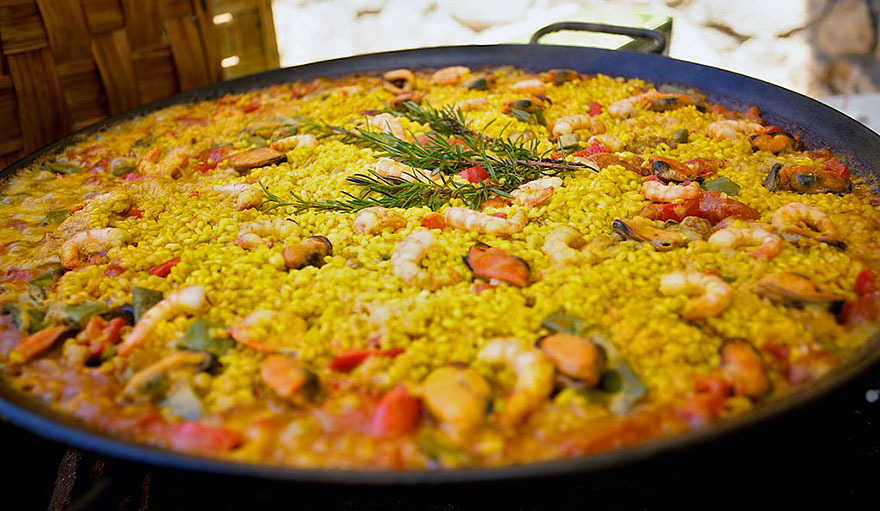
3. Paella Mixta
Another popular version, which originated outside of Valencia, is the mixed paella (paella mixta). It combines seafood, meat and vegetables in the same dish. In some restaurants, a mixed paella may also be served in the señorito / senyoret style, with bones and shells removed before the dish is served.
4. Paella Vegetariana
For vegetarian and vegan diners, the paella vegetariana is an excellent choice and every bit as flavorful and complex as the other varieties. It will often contain a mix of vegetables including artichokes, peppers and beans. Vegan diners should always ask if any non-vegetarian stock was used, or indeed if any other ingredients contained animal products. However, almost always this will not be the case.
5. Arròs Negre
Black paella (paella negra or arròs negre) is a seafood paella cooked with squid ink. This which transforms the dish from a warm golden-yellow to a silky black. The taste profile is also slightly richer, with the squid ink slightly covering some of the more delicate flavours such as saffron and rosemary.

If you like paella, don’t miss Fideuà
These are the five most popular paellas you will encounter during your travels in Spain. However, it would be remiss of us to leave out fideuà – another pan-based traditional “one-pot” served in many of the country’s coastal areas. Strictly speaking, this is NOT a paella, as it does not contain rice. Instead, rice is swapped for short, thin noodles and combined with monkfish, cuttlefish, squid and/or shrimp/prawns.
Catalans usually serve Fideuà with a dollop or two of alioli, a garlic and olive oil sauce, sometimes also mixed with egg to make it more of like a garlicky mayonnaise. The diner can use to mix themselves a creamier dish, or simply use as a small garnish. Dipping the fork into the alioli to give a small kick to the occasional bite is one of the pleasures here.

The mark of distinction when eating a well-executed paella is whether it comes with a thin layer of slightly burnt rice at the bottom and on the edges of the pan. In Catalan, this is called the socarrat and signifies a good rather than just average preparation. With fideuà it’s the other way around – the tops of the noodles are a little crunchy as they weren’t cooking in the stock for as long as the rest of the dish and therefore absorbed less liquid.
These are hearty, healthy meals, and any version will certainly fill you and thrill you. If you don’t fall in love with the first paella you try, try and try again. It’s almost impossible not to end up head over heels. Fortunately, we have the lowdown on Barcelona’s best eateries. Pull up a chair at any of these fine establishments and you are far more likely to experience love at first bite.
Best Paella Restaurants In Barcelona: Our Favourites
Restaurant Martínez
Paella with a view!
This popular restaurant located on the edge of Montjuic has excellent views over the port and sea. The menu features a variety of paellas as well as fideuàs. We recommend the rice dishes here. The arroz Martínez con conejo, pollo y verduras (rabbit, chicken and vegetables) or the arroz picante de pato y aceitunas Kalamata (a spicier dish with duck and olives) are to die for. Expect a long leisurely meal and be aware that most dishes tend to be a little on the salty side. The ambience, views and range of menu choices make it a great option for those site-seeing in or around the Montjuïc area.

Always make a reservation as this place is popular with locals and international visitors alike. When booking, ask for a good table outside, unless the forecast is for rain (though if it’s not too heavy a downpour you might be OK under the large awnings). After tasting one of the best paellas in Barcelona, if you have room, the cheesecake is also divine!
- Address: Ctra. de Miramar, 38 (Barcelona)
- Website: Restaurant Martínez
7 Portes
The classic option!
Founded in 1836, this well-known restaurant has been popular with international visitors (including the occasional celebrity!) for many years but remains a charming option for your paella experience. Still donning its elegant 19th-century decor, 7 Portes is one of the oldest restaurants in the city. It is well-located between many of the top attractions many visitors may wish to visit, making it a great option after site-seeing all morning or all afternoon. The setting and service will take you back to another time.
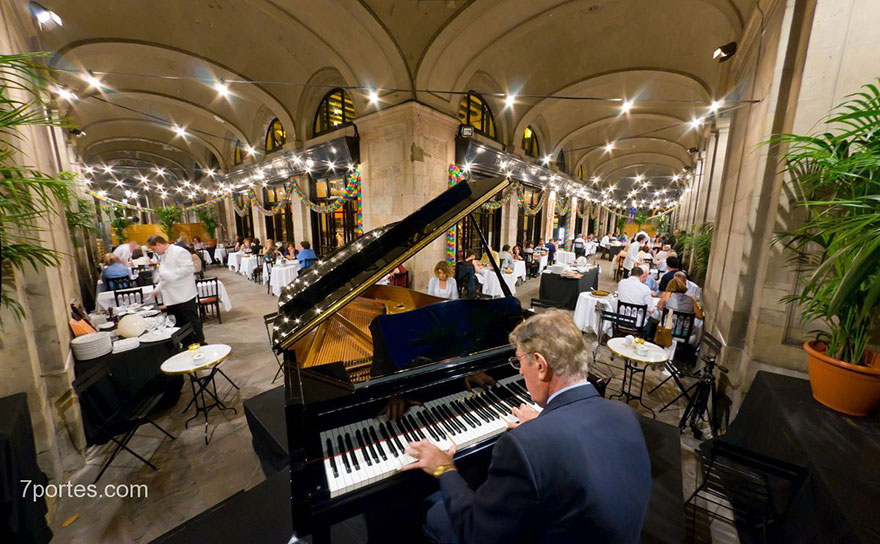
If you can’t decide what to eat, we suggest the paella parellada (like a mixed paella del senyoret). It is a special Barcelona-version of paella that this restaurant is known for pioneering.
We recommend sitting inside rather than outside to avoid traffic noise, plus on many evenings after 9 pm there is live music (most often piano). A limited number of tables are available for bookings but otherwise it is first come first served, so get there early and be prepared to wait.
- Address: Passeig d’Isabel II, 14 (Barcelona)
- Website: Les 7 Portes
L’arrosería Xàtiva
The best option for special dietary requirements!
With three branches in Sant Antoni, Les Corts and Gràcia, L’arrossería Xàtiva is well worth a visit for their exceptional range of paellas – no fewer than 25 varieties in fact! We prefer the Gràcia location as it tends to be a bit more casual and relaxed and is open seven days a week. The staff are attentive and accommodating.

We recommend any of their fideuàs, the paella de mar y montaña (a mixed paella of both seafood and meat), or one of their seasonal paellas. Their children’s menu also has a lot of choice making this a great option for a family paella trip.
Gluten-free travellers will be pleased to know that they cook most dishes with chickpea flour. They also cater well for travellers with lactose intolerance and offer a range of vegetarian options as well – each without compromising the quality.
- Address: Carrer del Torrent d’En Vidalet, 26 (Barcelona)
- Website: L’arrossería Xàtiva
Restaurant Elche
Quietly confident paella in the city’s theatre-district!
Despite serving up some of the best paellas in Barcelona out of their Poble Sec restaurant since the 1950s, many visitors will never hear about Elche. Well, in our view their excellent paellas and desserts (try the fig torte!) certainly keep us coming back for more.
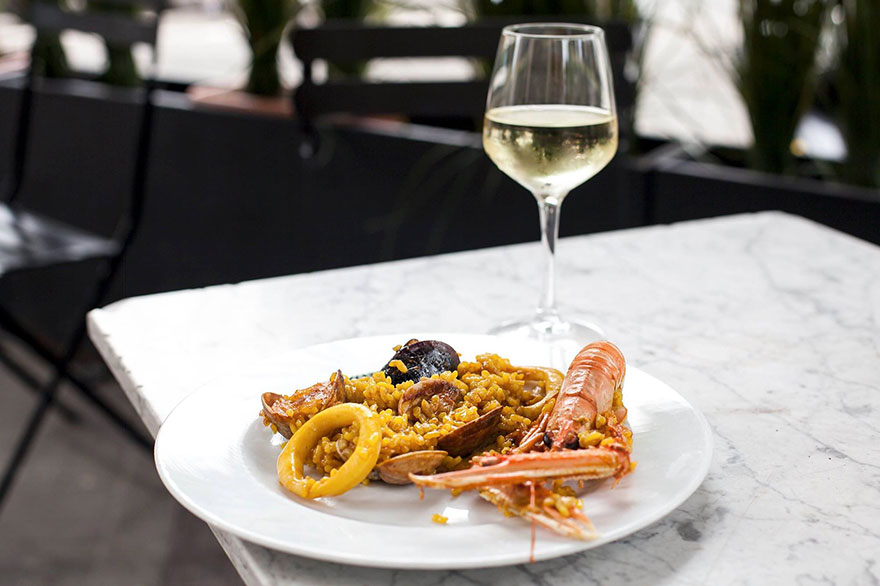
We particularly recommend the seafood paella here (chock full of shrimp, squid, mussels, clams and langoustine) or their mixed seafood and chicken paella. A light lemon sorbet for dessert rounds out the meal nicely.
- Address: Carrer de Vila i Vilà, 71
- Website: Elche restaurant
Arume
The city’s best duck paella!
With a Gallego founder and head chef, Arume mixes Galician and Mediterranean cuisines. It is located in the Raval neighbourhood, at the edge of Sant Antoni. It’s not an arroceria like most of the others on our list, but it is worthy of inclusion for its excellent duck paella. It is one of the best paellas in Barcelona. You won’t be disappointed!

They also have excellent yummy desserts. Be sure to make a reservation well in advance as it is a popular place and is usually booked up a few days in advance.
- Address: Carrer d’En Botella, 11
- Website: Arume restaurant
Envalira
The hidden gem!
It is a small place and a mythical restaurant in Gràcia neighbourhood. They are not terribly bothered about its decor and it is not the brightest restaurant inside (which you might welcome in the height of summer!). But their speciality is rice and they are very, very good at it indeed.
The waiters wear old school striped vests and are suitable attentive. We have a special place in our hearts for this place.
- Address: Plaça del Sol, 13
- Website: Envalira restaurant
Cheriff
Barceloneta’s best paella!
From the same owners of Elche, this restaurant is in the Barceloneta neighbourhood, near the waterfront and many popular touristic options. It has been recently renovated and so it’s out with the previously pretty retro decor, but we assure you the paella is still as amazing as ever!
- Address: Carrer de Ginebra, 15
- Website: Cheriff restaurant
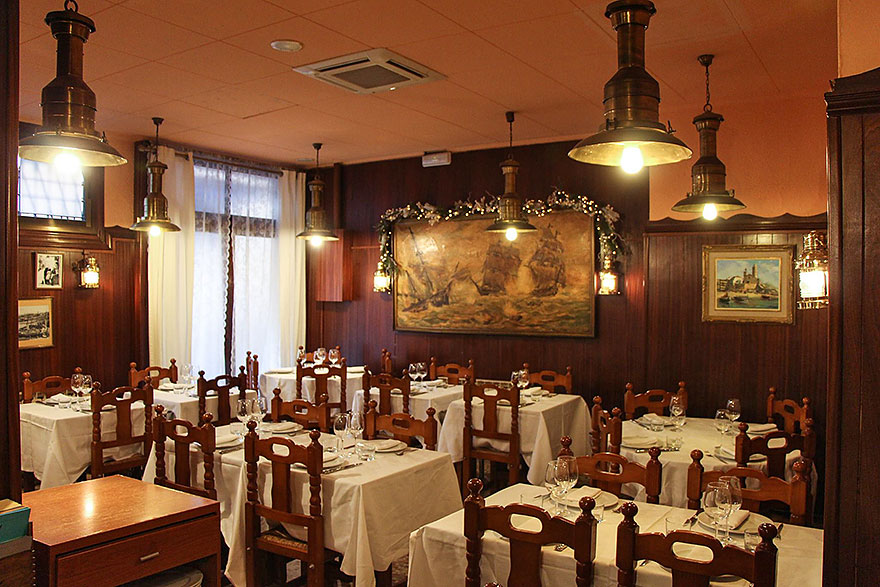
Els Pescadors
The petit alfresco option!
As its name indicates (“The Fishermen”) its speciality is fish, but they do three rice dishes that are excellent. They have a small terrace in the idyllic adjacent square that is a lovely spot for summer alfresco dining.
- Address: Plaça de Prim, 1
- Website: Els Pescadors
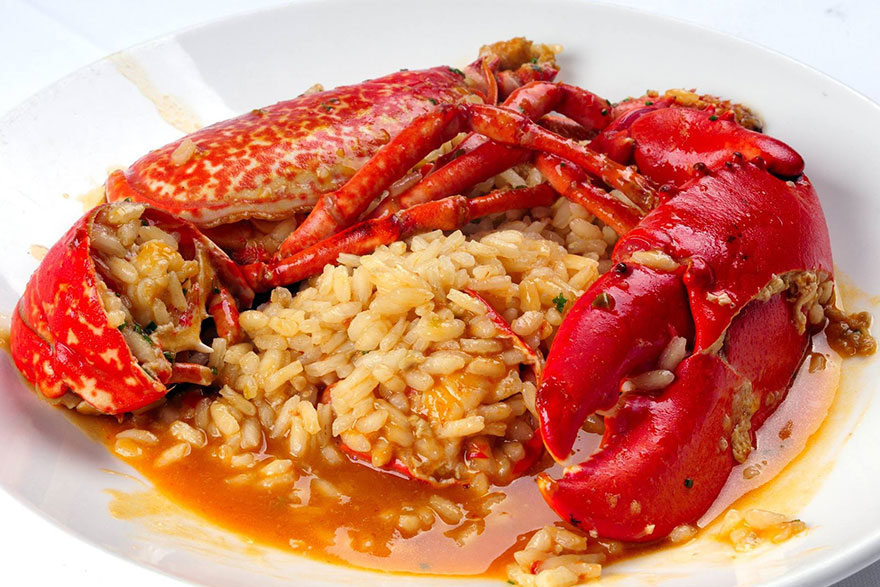
La Doncella de la Costa
Just outside the city limit and right beside the beach!
In Badalona, but easily reached by metro, this place is right on the beach, and they also have a patio where they sometimes do concerts. Views, music and great food = a fantastic meal out.
- Address: Passeig Marítim, 08911 (Badalona)
- Website: La Doncella de la Costa
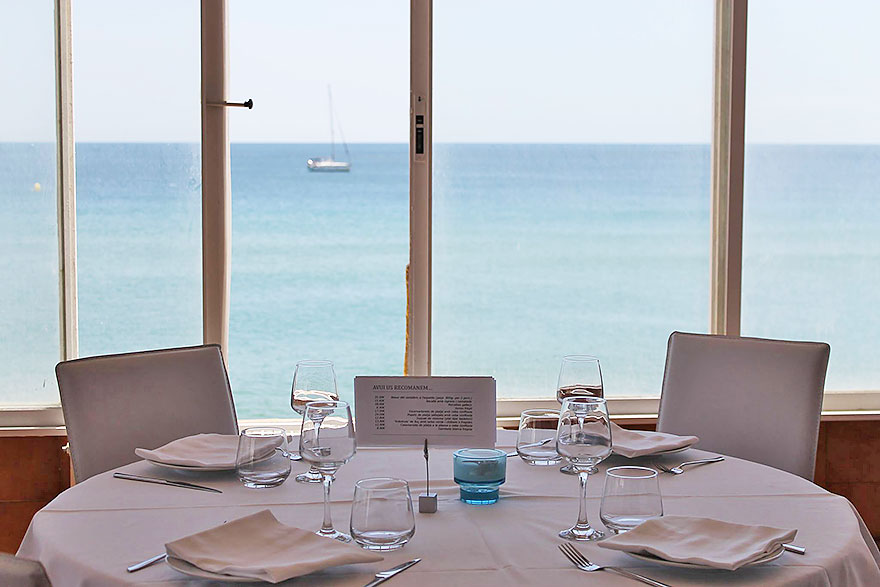
La Santa
Further afield – for seafood paella fresh from the sea!
This is for those paella-seekers willing to go the extra mile in order to get only the best paella. Hop on the R1 train from the centre of town and approximately 20 minutes later arrive at either El Masnou or Ocata station. Between the two stations, you will find a large marina and dozens of excellent restaurants. Find La Santa, which excels at paellas and a range of other seafood dishes – a great lunch option (1-4 pm every day) for a little jaunt away from the hubbub of the city.

Here we recommend the arròs negre or arròs del senyoret. If you have space for dessert, the lemon pie and crema catalana are fantastic. A range of high-quality local wines produced in the neighbouring area D.O. Alella is also available and highly recommended.
Reservations are recommended for lunches at the weekends but otherwise, there tends to be some space despite it being a locals’ favourite. Sit in the covered outside area to be as close as possible to the marina, which is suitable year-round.
- Address: Port Esportiu Manou local 74-75 (El Masnou)
- Website: La Santa
I hope you have enough information to know more about this traditional dish and start your quests for the best paella in Barcelona. Bon profit everyone!
Don’t forget that food exploration in Barcelona doesn’t end with paella. For small, personalised food tours in Barcelona, you can get in touch with the local experts who wrote this post at The Barcelona Taste. If Rick Steves thought they were the best, we are pretty sure you will too! Also, if you are heading for Madrid afterwards and got hooked on paella, our friends from OGO Tours can recommend you where to eat the best paella in Madrid.
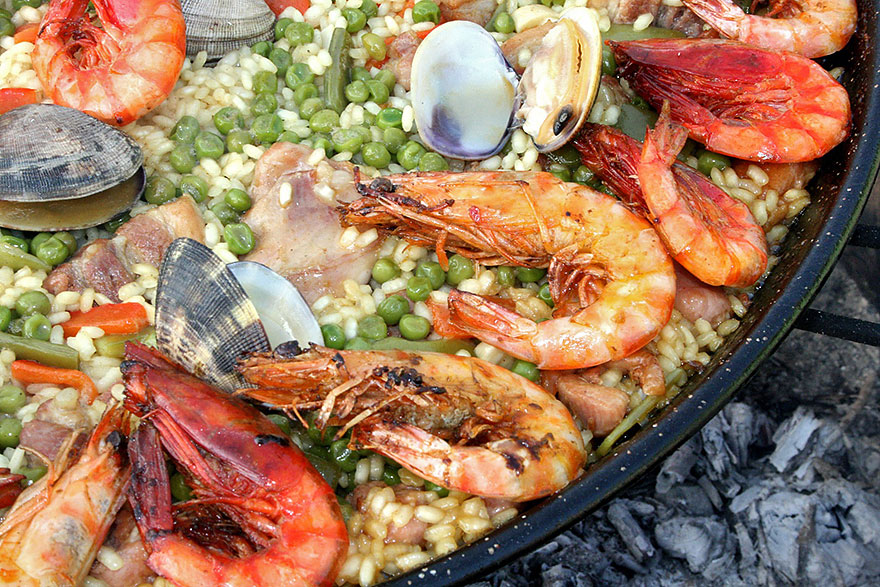











[…] of Santa Maria del Mar (in the photo). However, it rewards visitors with a charming neighbourhood full of restaurants and trendy […]